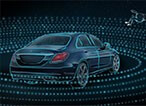Road safety example – How TAST can help save lives of drivers and animals

If a car is moving at 100 km/hr (62 mph), then at 152 m (500 ft), detection of a deer would allow 5.5 seconds to impact. Sound travels in air at 330m/second – so if the sound were emitted instantly upon detection (electronics should be fast) it would reach the animal’s ear in half a second.
Is that soon enough for the system to work? Yes, according to early calculations. Startle response latency in a large animal like a deer might be 0.3 seconds. Assuming processing time of 0.5 seconds in the brain to go from startle to an actual flight response, plus an additional 1.5 to 2 seconds it would take for a deer to get out way, the system would have about 3 seconds from the sound emission to the road being cleared – time enough to avoid our 62mph car. This is a highly realistic and promising outcome for the system to achieve.
GenusWave’s Targeted Acoustic Startle Technology (TAST) has a deterrent capability that can provide improved road safety. An array of sensors (e.g. ultrasound or infrared based) detects the presence of an animal on the road. The sensor triggers a directional loudspeaker which projects a specific, high-intensity noise pulse that temporarily exceeds the noise of the vehicle’s engine.
The animals then abandon any ongoing behavior and immediately exhibit a flight response away from the loudspeaker. The sound pulse will be projected at a frequency where the animals’ hearing sensitivity is high and the engine noise is moderate. The continuous engine noise will at most be advantageous as it provides a baseline noise floor against which the startle response can be elicited.
 Go Back
Go Back












